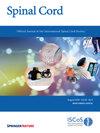The feasibility and utility of intraoperative ultrasound in spinal cord injury patients: an international survey of AO spine members
IF 2.2
4区 医学
Q3 CLINICAL NEUROLOGY
引用次数: 0
Abstract
Survey. Intraoperative ultrasound (IOUS) is an emerging tool for assessing the injured spinal cord during surgical intervention and particularly after traumatic spinal cord injury (SCI). The extent of utilization of this technique is unknown. To assess whether a knowledge gap exists regarding IOUS in managing SCI patients, an international survey of spine surgeons was performed. International Survey. Members of the AO Spine international community were surveyed using a web-based questionnaire developed by an SCI expert commission. The categorical data were analyzed descriptively. Of the 276 completed surveys, 22% (n = 61/276) indicated IOUS was utilized during spine surgery, with most responses coming from Europe (38% n = 24/61) and North America (30% n = 18/61). Only 41% (n = 25/61) had received formal IOUS training. There were 59% (n = 36/61) of respondents who indicated they use IOUS on patients with acute SCI, mainly to assess adequate decompression. Of those not using IOUS, 50% (n = 107/215) did not have access to an ultrasound machine available. Overall, 92% (n = 254/276) indicated that an IOUS training course would be beneficial to improve understanding and patient care. This international survey of spine surgeons demonstrated that currently, there is limited use of IOUS in the surgical management of acute SCI. Understanding the needs of spine surgeons and tailoring educational opportunities may increase the role of IOUS. Given the importance of surgical decompression in enhancing outcomes after acute SCI coupled with the ability of IOUS to assess decompression, greater adoption of IOUS could further enhance the efficacy of decompressive surgery.

术中超声在脊髓损伤患者中的可行性和实用性:AO脊柱成员的一项国际调查。
研究设计:调查。目的:术中超声(IOUS)是外科手术中评估脊髓损伤的一种新兴工具,特别是在创伤性脊髓损伤(SCI)后。这种技术的应用程度尚不清楚。为了评估在管理脊髓损伤患者中是否存在关于欠条的知识差距,对脊柱外科医生进行了一项国际调查。设置:国际调查。方法:使用由SCI专家委员会开发的基于网络的问卷调查AO Spine国际社区的成员。分类数据进行描述性分析。结果:在完成的276份调查中,22% (n = 61/276)表示在脊柱手术中使用了借据,大多数受访者来自欧洲(38% n = 24/61)和北美(30% n = 18/61)。只有41% (n = 25/61)接受过正式的欠条培训。59% (n = 36/61)的受访者表示,他们对急性脊髓损伤患者使用欠条,主要是为了评估是否足够的减压。在不使用借条的患者中,50% (n = 107/215)没有使用可用的超声机。总的来说,92% (n = 254/276)的人表示,白条培训课程将有助于提高理解和患者护理。结论:这项对脊柱外科医生的国际调查表明,目前在急性脊髓损伤的外科治疗中使用欠条的情况有限。了解脊柱外科医生的需求和调整教育机会可能会增加借据的作用。考虑到手术减压对提高急性脊髓损伤后预后的重要性,再加上借据评估减压的能力,更多地采用借据可以进一步提高减压手术的疗效。
本文章由计算机程序翻译,如有差异,请以英文原文为准。
求助全文
约1分钟内获得全文
求助全文
来源期刊

Spinal cord
医学-临床神经学
CiteScore
4.50
自引率
9.10%
发文量
142
审稿时长
2 months
期刊介绍:
Spinal Cord is a specialised, international journal that has been publishing spinal cord related manuscripts since 1963. It appears monthly, online and in print, and accepts contributions on spinal cord anatomy, physiology, management of injury and disease, and the quality of life and life circumstances of people with a spinal cord injury. Spinal Cord is multi-disciplinary and publishes contributions across the entire spectrum of research ranging from basic science to applied clinical research. It focuses on high quality original research, systematic reviews and narrative reviews.
Spinal Cord''s sister journal Spinal Cord Series and Cases: Clinical Management in Spinal Cord Disorders publishes high quality case reports, small case series, pilot and retrospective studies perspectives, Pulse survey articles, Point-couterpoint articles, correspondences and book reviews. It specialises in material that addresses all aspects of life for persons with spinal cord injuries or disorders. For more information, please see the aims and scope of Spinal Cord Series and Cases.
 求助内容:
求助内容: 应助结果提醒方式:
应助结果提醒方式:


